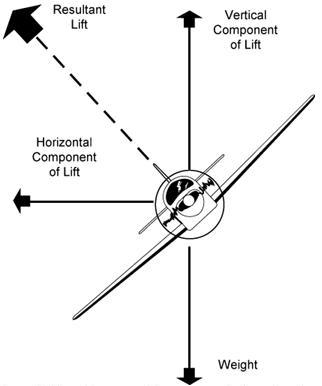With the wings level, lift acts directly opposite to gravity. However, as the airplane is banked, gravity still acts in a vertical plane, but lift will now act in an inclined plane.
As illustrated in figure 1-40, the force of lift can be resolved
into two components, vertical and horizontal. During the turn entry, the
vertical component of lift still opposes gravity, and the horizontal component
of lift must overcome apparent centrifugal force. Consequently, the total
lift must be sufficient to counteract both of these forces.
The total resultant lift acts opposite to the total resultant
load. So long as these opposing forces are equal to each other in magnitude,
the airplane will maintain a constant rate of turn. If the pilot moves
the controls in such a manner as to change the magnitude of any of the
forces, the airplane will accelerate or decelerate in the direction of
the applied force. This will result in changing the rate at which the airplane
turns.
